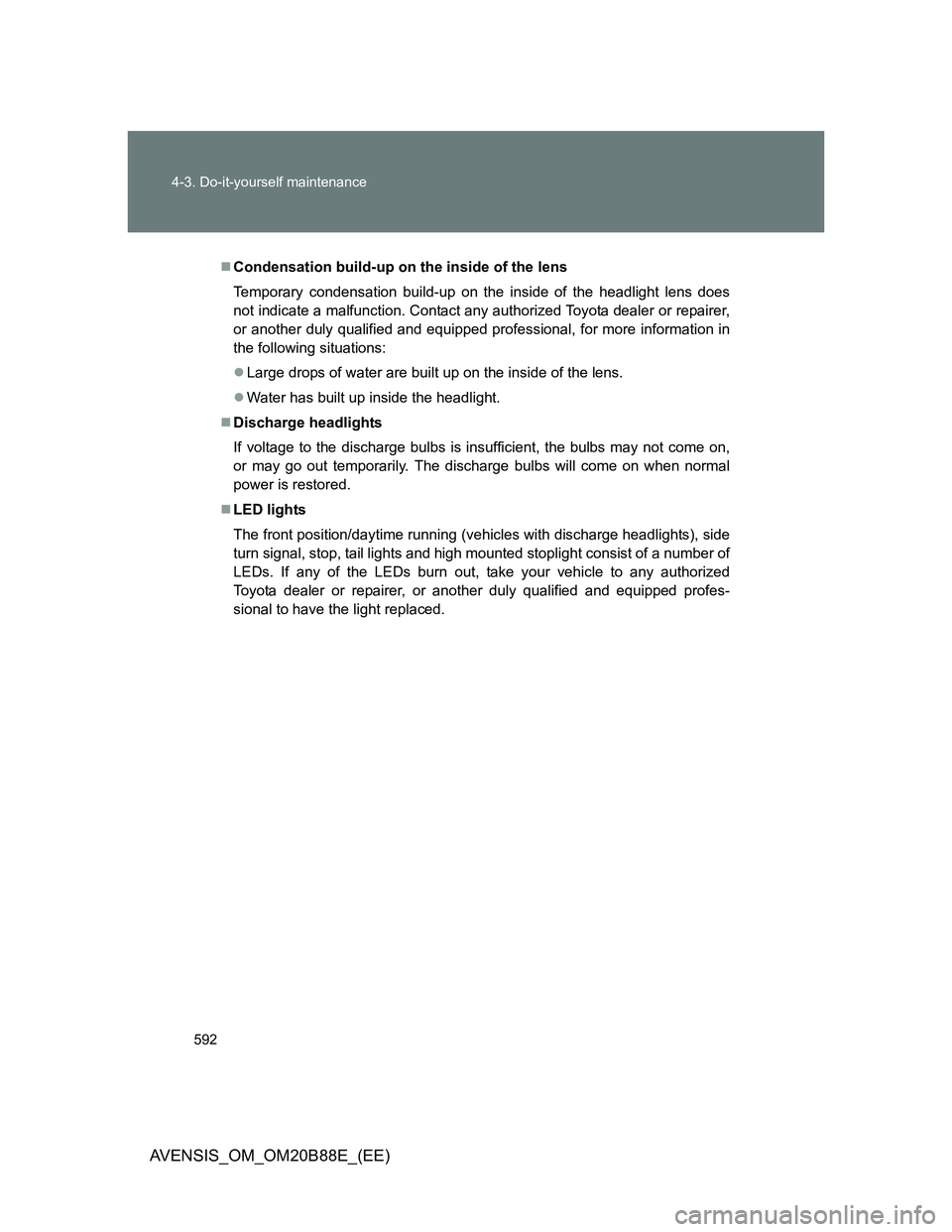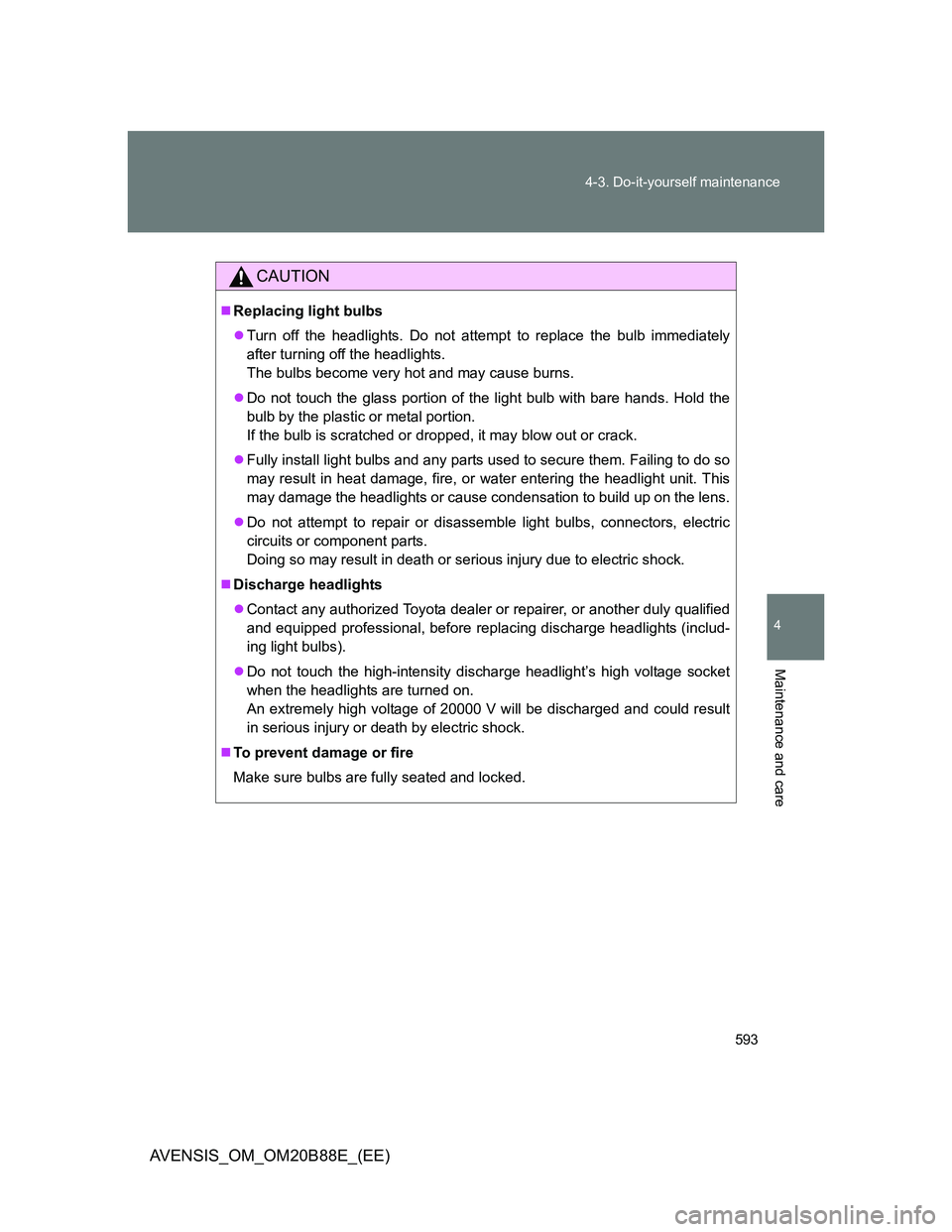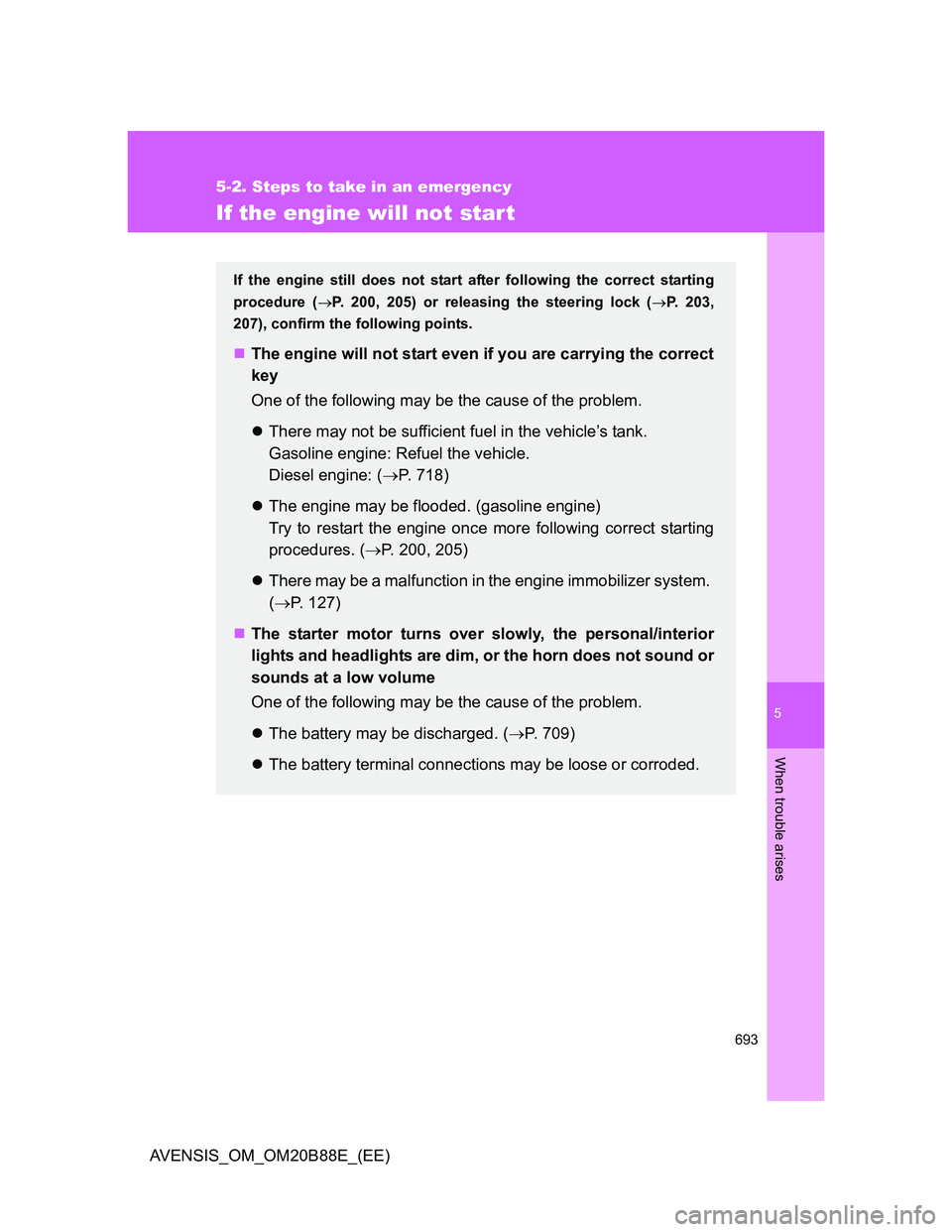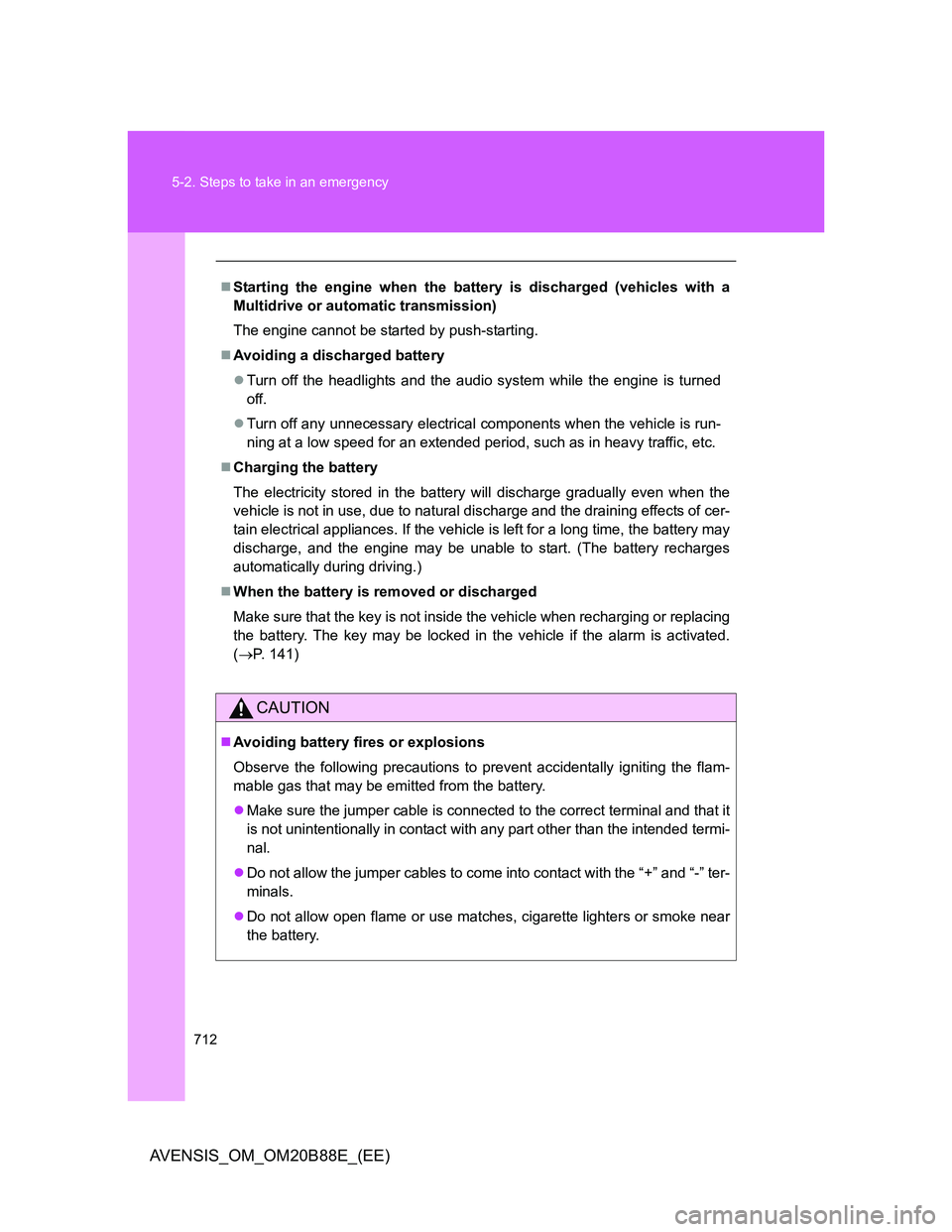Page 590 of 776
590 4-3. Do-it-yourself maintenance
AVENSIS_OM_OM20B88E_(EE)Replacing the following bulbs
If any of the lights listed below has burnt out, have it replaced by
any authorized Toyota dealer or repairer, or another duly qualified
and equipped professional.
Headlight low or high beams (vehicles with discharge head-
lights)
Front position/daytime running lights (vehicles with discharge
headlights)
Side turn signal lights
Stop lights
Tail lights
High mounted stoplight
Page 592 of 776

592 4-3. Do-it-yourself maintenance
AVENSIS_OM_OM20B88E_(EE)
Condensation build-up on the inside of the lens
Temporary condensation build-up on the inside of the headlight lens does
not indicate a malfunction. Contact any authorized Toyota dealer or repairer,
or another duly qualified and equipped professional, for more information in
the following situations:
Large drops of water are built up on the inside of the lens.
Water has built up inside the headlight.
Discharge headlights
If voltage to the discharge bulbs is insufficient, the bulbs may not come on,
or may go out temporarily. The discharge bulbs will come on when normal
power is restored.
LED lights
The front position/daytime running (vehicles with discharge headlights), side
turn signal, stop, tail lights and high mounted stoplight consist of a number of
LEDs. If any of the LEDs burn out, take your vehicle to any authorized
Toyota dealer or repairer, or another duly qualified and equipped profes-
sional to have the light replaced.
Page 593 of 776

593 4-3. Do-it-yourself maintenance
4
Maintenance and care
AVENSIS_OM_OM20B88E_(EE)
CAUTION
Replacing light bulbs
Turn off the headlights. Do not attempt to replace the bulb immediately
after turning off the headlights.
The bulbs become very hot and may cause burns.
Do not touch the glass portion of the light bulb with bare hands. Hold the
bulb by the plastic or metal portion.
If the bulb is scratched or dropped, it may blow out or crack.
Fully install light bulbs and any parts used to secure them. Failing to do so
may result in heat damage, fire, or water entering the headlight unit. This
may damage the headlights or cause condensation to build up on the lens.
Do not attempt to repair or disassemble light bulbs, connectors, electric
circuits or component parts.
Doing so may result in death or serious injury due to electric shock.
Discharge headlights
Contact any authorized Toyota dealer or repairer, or another duly qualified
and equipped professional, before replacing discharge headlights (includ-
ing light bulbs).
Do not touch the high-intensity discharge headlight’s high voltage socket
when the headlights are turned on.
An extremely high voltage of 20000 V will be discharged and could result
in serious injury or death by electric shock.
To prevent damage or fire
Make sure bulbs are fully seated and locked.
Page 628 of 776
628 5-2. Steps to take in an emergency
AVENSIS_OM_OM20B88E_(EE)
(Flashes)
(If equipped)Indicates that there is
a possibility of a fron-
tal collisionSlow the vehicle by
applying the brakes.
(Flashes)
(If equipped)Indicates that there is
a high possibility of a
frontal collision, or
that the pre-crash
braking function is
operatingSlow the vehicle by
applying the brakes.
(Flashes)Indicates that the
headlight have been
left onTurn off the headlights.
Warning messageDetailsCorrection procedure
Page 693 of 776

5
693
5-2. Steps to take in an emergency
When trouble arises
AVENSIS_OM_OM20B88E_(EE)
If the engine will not start
If the engine still does not start after following the correct starting
procedure (P. 200, 205) or releasing the steering lock (P. 203,
207), confirm the following points.
The engine will not start even if you are carrying the correct
key
One of the following may be the cause of the problem.
There may not be sufficient fuel in the vehicle’s tank.
Gasoline engine: Refuel the vehicle.
Diesel engine: (P. 718)
The engine may be flooded. (gasoline engine)
Try to restart the engine once more following correct starting
procedures. (P. 200, 205)
There may be a malfunction in the engine immobilizer system.
(P. 127)
The starter motor turns over slowly, the personal/interior
lights and headlights are dim, or the horn does not sound or
sounds at a low volume
One of the following may be the cause of the problem.
The battery may be discharged. (P. 709)
The battery terminal connections may be loose or corroded.
Page 694 of 776
694 5-2. Steps to take in an emergency
AVENSIS_OM_OM20B88E_(EE)
The starter motor does not turn over (vehicles with smart
entry & start system)
The engine starting system may be malfunctioning due to an
electrical problem such as an open circuit or a blown fuse. How-
ever, an interim measure is available to start the engine.
(P. 695)
The starter motor does not turn over, the personal/interior
lights and headlights do not turn on, or the horn does not
sound
One of the following may be the cause of the problem.
One or both of the battery terminals may be disconnected.
The battery may be discharged. (P. 709)
There may be a malfunction in the steering lock system. (vehi-
cles with smart entry & start system)
Contact any authorized Toyota dealer or repairer, or another duly
qualified and equipped professional, if the problem cannot be
repaired, or if repair procedures are unknown.
Page 712 of 776

712 5-2. Steps to take in an emergency
AVENSIS_OM_OM20B88E_(EE)
Starting the engine when the battery is discharged (vehicles with a
Multidrive or automatic transmission)
The engine cannot be started by push-starting.
Avoiding a discharged battery
Turn off the headlights and the audio system while the engine is turned
off.
Turn off any unnecessary electrical components when the vehicle is run-
ning at a low speed for an extended period, such as in heavy traffic, etc.
Charging the battery
The electricity stored in the battery will discharge gradually even when the
vehicle is not in use, due to natural discharge and the draining effects of cer-
tain electrical appliances. If the vehicle is left for a long time, the battery may
discharge, and the engine may be unable to start. (The battery recharges
automatically during driving.)
When the battery is removed or discharged
Make sure that the key is not inside the vehicle when recharging or replacing
the battery. The key may be locked in the vehicle if the alarm is activated.
(P. 141)
CAUTION
Avoiding battery fires or explosions
Observe the following precautions to prevent accidentally igniting the flam-
mable gas that may be emitted from the battery.
Make sure the jumper cable is connected to the correct terminal and that it
is not unintentionally in contact with any part other than the intended termi-
nal.
Do not allow the jumper cables to come into contact with the “+” and “-” ter-
minals.
Do not allow open flame or use matches, cigarette lighters or smoke near
the battery.
Page 748 of 776
748 6-1. Specifications
AVENSIS_OM_OM20B88E_(EE)
Light bulbs
A: H11 halogen bulbs B: D4S discharge bulbs
C: H9 halogen bulbs D: Wedge base bulbs (amber)
E: Wedge base bulbs (clear) F: H16 halogen bulbs
G: Single end bulbs (amber) H: Single end bulbs (clear)
I: Double end bulbs
Light BulbsWTy p e
ExteriorHeadlights
Low beam
Halogen bulbs
Discharge bulbs
High beam
Halogen bulbs
Discharge bulbs55
35
65
35A
B
C
B
Front turn signal lights 21 D
Front position/daytime running lights
(vehicles with halogen headlights)5/21 E
Front fog lights 19 F
Rear turn signal lights 21 G
Back-up light
For sedan
For wagon16
21E
H
Rear fog lights 21 H
License plate lights 5 E
InteriorPersonal/interior lights 8 E
Vanity lights 8 E
Door courtesy lights 5 I
Trunk/luggage compartment light 5 I